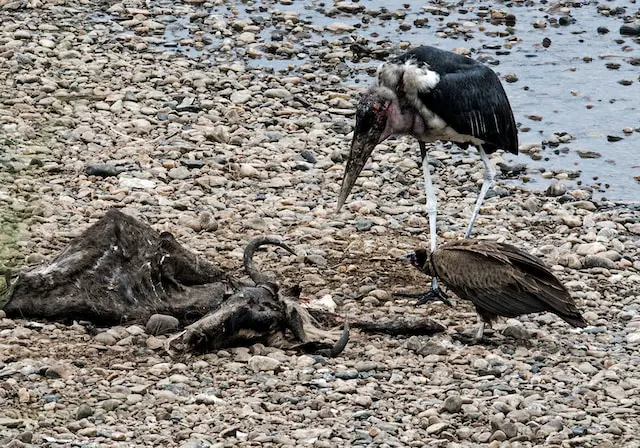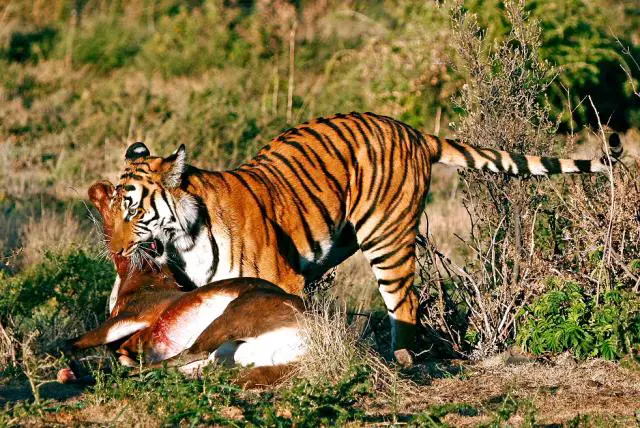Carnivores are animals that primarily hunt and consume live prey, while scavengers are animals that primarily feed on carrion or the remains of dead animals.
TL;DR Carnivores Vs. Scavengers
Carnivores possess specialized adaptations such as sharp teeth and strong jaws to capture prey efficiently. They are skilled hunters that actively pursue their food source.
Scavengers serve as nature’s cleanup crew by feeding on carcasses left behind by predators or found in their environment. They have adaptations like powerful beaks for tearing flesh or strong digestive systems to process decaying matter safely.
What is a carnivore?

Carnivores have an insatiable appetite for meat and rely solely on hunting other animals to satisfy their nutritional needs. Carnivores have evolved specialized teeth and powerful jaws designed for tearing flesh. Their sharp claws and speed make them formidable hunters.
Carnivores come in various shapes and sizes, ranging from majestic big cats like lions and tigers to agile canines such as wolves and foxes. Even birds like eagles and owls fall under this category due to their diet consisting primarily of small mammals.
What is a scavenger?

Scavengers are opportunistic feeders, relying on the remains of dead animals for sustenance. Scavengers prefer to scavenge or feed on carrion.
Scavengers have an incredible sense of smell and can detect carcasses from miles away. They swoop in to feast on decaying flesh, helping to clean up the environment by preventing the spread of diseases that could arise from decomposing bodies.
Scavengers serve as nature’s recyclers, efficiently disposing of organic matter that would otherwise go unused. By consuming carrion and returning nutrients back into the ecosystem through their waste products, they contribute to maintaining balance within various habitats around the world.
Carnivores Vs. Scavengers – Key differences
| Aspect | Carnivores | Scavengers |
|---|---|---|
| Diet | Meat-eaters, primarily hunt and kill prey | Feed on animal carcasses or already dead animals |
| Feeding Behavior | Active hunters, pursue live prey | Passive feeders, consume carrion |
| Adaptations | Sharp teeth and claws for capturing and killing | Specialized scavenging adaptations |
| Digestive System | Short digestive tracts to process animal proteins | Adapted to digesting decaying flesh |
| Hunting Techniques | Stalking, chasing, and ambushing prey | Search and locate carrion through scavenging |
| Ecological Role | Regulate prey populations, part of food chains | Clean up and recycle organic matter |
| Examples | Lions, wolves, tigers, eagles | Vultures, hyenas, raccoons, crows, and jackals |
Examples of carnivores
- Lion: A social big cat known for hunting and living in prides in Africa.
- Wolf: A pack-living predator with sharp hunting instincts, found in various habitats across the world.
- Cheetah: The fastest land animal, built for explosive speed during chases, found in African savannas.
- Polar Bear: A skilled swimmer and hunter of seals in the Arctic regions.
- Tiger: The largest cat species, a solitary hunter with a global presence in Asian habitats.
- Eagle: A powerful bird of prey with keen eyesight, hunting smaller animals from the skies.
- Crocodile: A reptile predator found in tropical regions, using stealth to ambush its prey.
- Great White Shark: An apex ocean predator, known for its formidable hunting capabilities.
- Hyena: A scavenger and opportunistic hunter with a strong bite, mainly inhabiting Africa and parts of Asia.
- Jaguar: A stealthy big cat, equipped with powerful jaws, found in the Americas’ rainforests and grasslands.
Examples of scavengers
- Vulture: A bird that primarily feeds on carrion, playing a crucial role in cleaning up decaying animal remains.
- Hyena: Known for scavenging the leftovers of other predators’ kills, in addition to hunting and killing small prey.
- Raccoon: An opportunistic scavenger that consumes a wide variety of food, including scavenged carcasses.
- Jackal: Often seen scavenging on animal carcasses and leftover food, living in diverse habitats across the world.
- Crow: Highly intelligent birds that scavenge on both animal and human food waste.
- Marabou Stork: A large bird found in Africa, often seen scavenging at the edges of water bodies.
- Tasmanian Devil: This marsupial scavenges on carrion, using its strong jaws to access meat.
- Brown Rat: An adaptable rodent often found scavenging in urban environments.
- Gila Monster: A venomous lizard that scavenges on carrion and preys on small animals when opportunities arise.
- Dingo: Wild dogs native to Australia, known to scavenge on animal remains and hunt opportunistically.
Why are there both carnivores and scavengers?
The presence of both carnivores (animals that primarily hunt and kill prey for their food) and scavengers (animals that primarily feed on carrion or the remains of already dead animals) is essential for the balance and functioning of ecosystems.
Each plays a unique role in the ecological community, contributing to the efficient cycling of nutrients and maintaining biodiversity. Here are some reasons why both carnivores and scavengers exist:
Nutrient Recycling: Scavengers play a crucial role in the ecosystem by recycling nutrients. They feed on decaying matter, breaking it down into simpler compounds and returning those nutrients to the soil.
Efficient Energy Use: Scavengers optimize energy use by obtaining food with relatively less effort compared to carnivores that need to hunt live prey.
Limiting Disease Spread: Scavengers help in reducing the risk of disease transmission by consuming carrion that might otherwise become a breeding ground for pathogens.
Predation Control: Carnivores help regulate prey populations by controlling the numbers of herbivores in an ecosystem.
Ecological Balance: The coexistence of both carnivores and scavengers helps maintain a delicate balance in food webs. Carnivores control herbivore populations, and scavengers contribute to the recycling of nutrients.
Diverse Adaptations: Carnivores are typically equipped with hunting instincts and physical attributes like sharp teeth and claws, while scavengers possess unique physiological adaptations to process carrion.
Food Availability: The presence of both carnivores and scavengers allows for a more efficient use of available food resources. Carnivores focus on capturing live prey, while scavengers help prevent waste by consuming dead animals.
Overall, the coexistence of carnivores and scavengers ensures a complex and interconnected web of interactions within ecosystems, promoting the overall health and sustainability of natural environments.
Their roles are complementary and contribute to the overall ecological balance and functioning of ecosystems.
Image Credits
Featured Image By – China’s Tiger at English Wikipedia, CC BY-SA 2.5, via Wikimedia Commons
Image 1 By – Mathias Appel, CC0, via Wikimedia Commons
Image 2 By – David Clode on Unsplash









